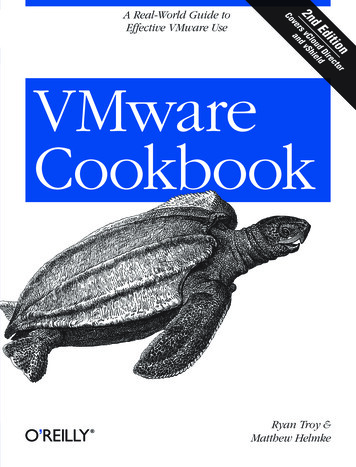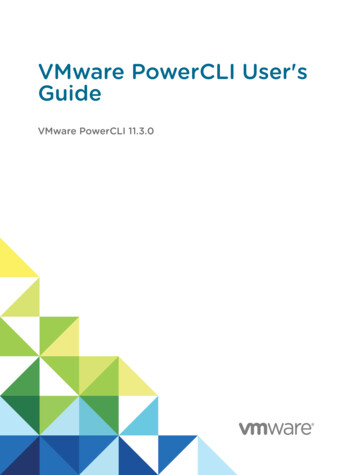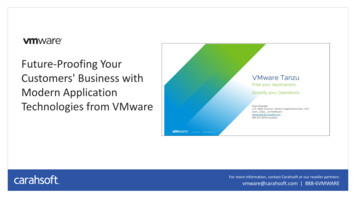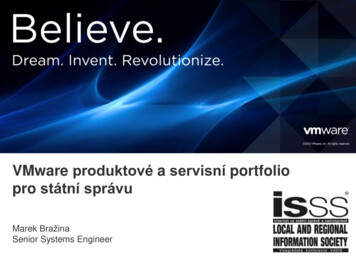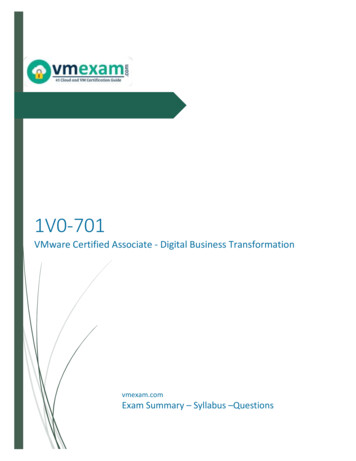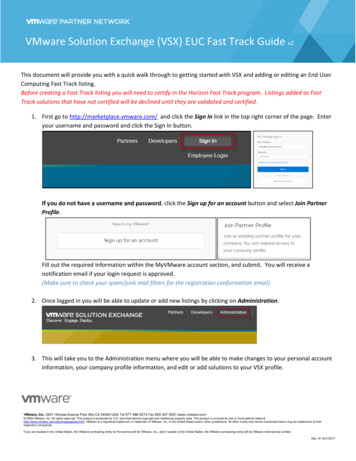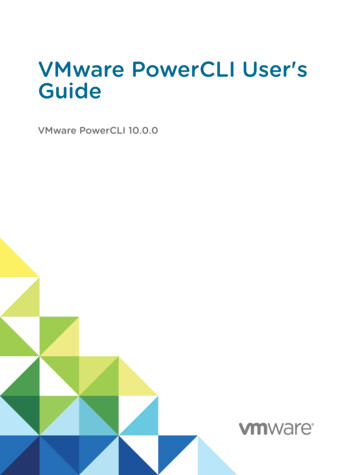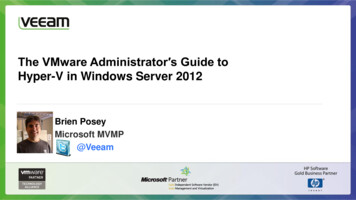
Transcription
The VMware Administrator′s Guide toHyper-V in Windows Server 2012Brien PoseyMicrosoft MVMP@Veeam
About today’s webinar Thought leadership content from an industry expert This webinar is recorded and you will get a link to replaythe webinar as well as download slides. Ask questions!
About our speaker Nine time Microsoft MVP Freelance author and industry analyst since 2001 Formerly CIO for a national chain of hospitals andhealthcare facilities Served as a network engineer for the DoD at Fort Knox Worked as a network administrator for some of thecountry’s largest insurance companies
Agenda Why bother learning Hyper-V? Hyper-V and VMware basics Hyper-V equivalents to VMware features
Full disclosure I am a Microsoft MVP and work with Hyper-V on a dailybasis. This presentation is not about convincing you to switchto Hyper-V, or about which hypervisor is better. The purpose of this presentation is to expose VMwareadmins to Hyper-V and Visa Versa.
Why learn Hyper-V? VMware is the undisputed leader of the servervirtualization market – for now. Hyper-V 3.0 and VMware 5 are more similar than manyadmins realize. Heterogeneous hypervisor environments are sure tobecome more common Hyper-V costs less and is less expensive. You mightencounter Hyper-V as a result of: Corporate mergers Internal transitions Low budget projects
A basic deploymentVMwareHyper-VVMware uses a selfcontained OS that installsdirectly on a dedicatedserver.Although there is astandalone version ofHyper-V, most Hyper-Vdeployments run as aservice on top of a parentWindows OS.
Hardware considerationsVMwareHyper-VRequires a 64-bit CPU withhardware level virtualizationRequires a 64-bit CPU withhardware level virtualizationVery limited support forSATA drivesWorks with SATA, SAS, andSSDsRequires dedicated storagefor the datastoreDoesn’t technically requirededicated storage, but bestpractice is to use dedicatedstorage
ScalabilityVMware vSphere 5Hyper-V 3.0Maximum RAM supported within a VM1 TB512 GBMaximum virtual hard disk size2 TB16 TB if using VHDXMaximum number of virtual CPUs per virtual machine3232The maximum number of virtual machines per host thatcan be powered on at any given time5121024Maximum number of virtual machines in a cluster30004000Maximum number of hosts per cluster3263Maximum RAM per host server2 TB2 TB
Interacting with the hypervisorVMwareHyper-VBasic configuration isperformed through theserver consoleBasic configuration isperformed through theHyper-V Manager (on theserver)VM configuration andmanagement is performedthough the vSphere ClientVM configuration andmanagement is performedthrough the Hyper-VManager or throughWindows PowerShell.
Virtual machinesVMwareHyper-VEnlightenmentVMware ToolsIntegrationServicesSettingsRight click on theVM in thevSphere clientand choose EditSettingsRight click on theVM in the HyperV Manager andchoose Settings
Advanced features The features discussed so far represent the most basicaspects of server virtualization. Both Hyper-V and VMware offer a number of advancedfeatures that are designed to make server virtualizationpractical in a production environment. Many of these features exist on both platforms, but havedifferent names.
Hyper-V main areas of improvement MemoryStorageNetworkingHigh AvailabilityDisaster Recovery
Memory Memory over commitment Memory ballooning
Memory over commitment Memory over commitment allows virtual machines to becollectively assigned more memory than is physicallypresent in the host, allowing for greater VM density. VMware has had a memory over commitment featurefor quite some time. Microsoft introduced memory over commitment inHyper-V 2.0 (Windows Server 2008 R2).
Memory ballooning Memory ballooning allows VMs to release unusedmemory after the initial boot process completes. Memory ballooning is supported by both VMware andHyper-V
Storage Storage supportStorage migrationsConcurrent storage migrationsLow cost storage optionsOffload Data Transfer
Storage supportVMwareHyper-VBlock level storageiSCSI and FibreChanneliSCSI and FibreChannelFile system storageNFSSMB
Storage migrations Storage migration refers to the ability to move a runningvirtual machine from one host to another. Microsoft refers to this as “Live Migration”. VMware callsit vMotion. Live Migration was introduced in Hyper-V 2.0 (WindowsServer 2008 R2). Hyper-V 3.0 still offers live migration, but removes therequirement for shared storage.
Concurrent storage migrations VMware allows for 2 concurrent storage migrations perdatastore and up to 8 concurrent migrations per host. Concurrent live migrations are new to Hyper-V 3.0,which supports an unlimited number of simultaneouslive migrations.
Low cost storage options VMware – use vSphere Storage Appliance (VSA). Creates shared storage from local disks Additional license is required. Hyper-V – Shared storage is not required in version 3.0 Hosts can use local storage.
Offloaded data transfer Both VMware and Hyper-V can offload file transfers tothe storage hardware VMware uses VAAI (vStorage API for Array Integration) Hyper-V / Windows Server 2012 use Offloaded Data Transfer (ODX)
Networking NIC Teaming Extensible Virtual Switch
NIC teaming NIC teaming allows multiple physical NICs to worktogether to achieve higher bandwidth and faulttolerance. NIC teaming is supported by VMware and Hyper-V 3.0. Earlier versions of Hyper-V allowed NIC teaming, butonly at the hardware level.
Extensible virtual switch The extensible virtual switch lets third party vendors tobuild extensions for the virtual switch. This will allow virtual switches to be monitored andmanaged in a manner similar to that used for physicalswitches. VMware and Hyper-V both offer an extensible virtualswitch.
High availability Failover ClusteringMigration of running virtual machinesConcurrent migrationsLive migration – Beyond the clusterControllable virtual machine placement
Failover clustering
Failover ClusteringVMwareHyper-VFeature NameVMware HAFailover ClusteringMaximum Number ofNodes3263Maximum Number ofVirtual Machines perCluster30004000Shared StorageSupportedYesYesShared Storage RequiredYesNo
Concurrent virtual machine migrationsvMotionLive Migration2 per datastore, 8 per host (4 on a 1Gigabit connection, 8 on a 10gigabit connection)Unlimited in Hyper-V 3.0, butbandwidth must be considered.Limited to 1 in Hyper-V 2.0
Live Migration – Beyond the cluster Hyper-V 3.0 has the ability to live migrate virtualmachines to nodes that exist outside of the cluster. VMware does not yet have this capability.
Controllable virtual machine placement It is sometimes necessary to control virtual machine placementduring failover. Some VMs must reside on the same host. Other VMs should neverreside on the same host. If a host is overloaded VMs must be prioritized to control which VMsstart and which do not.VMwareHyper-VHost rules, Affinity rules, and Anti-AffinityrulesCluster properties can be configured withAffinity and Anti-Affinity rules. VM startupcan be prioritized.
Disaster recovery Incremental block level backups Disaster recovery options Snapshot merge
Incremental block level backupsVMwareHyper-VBased on Change Block TrackingWindows Server 2012 supportsincremental backups of virtual harddisks.
Replication-based disaster recovery optionsVMwareHyper-VFeaturevCenter Site RecoveryManagerHyper-V ReplicaLicensingRequires additionallicenseBuilt-in to Hyper-V 3.0
Snapshot supportVMwareHyper-V 2.0Hyper-V 3.0Snapshots can bedeleted or mergedwithout restarting theVM.Snapshots were fullysupported, but couldonly be deleted ormerged while the VMwas offline.Snapshots can bedeleted or mergedwhile the virtualmachine is running.
Hot resource allocation Hot resource allocation refers to adding physicalresources to a VM while it is running.VMwareHyper-VMemoryYesYesDiskYesYesCPU CoresYesNo
Conclusion Hyper-V is finally becoming a contender Virtualization admins may soon have to support bothplatforms
Q&A Thank you for attending!
Why learn Hyper-V? VMware is the undisputed leader of the server virtualization market - for now. Hyper-V 3.0 and VMware 5 are more similar than many admins realize. Heterogeneous hypervisor environments are sure to become more common Hyper-V costs less and is less expensive. You might encounter Hyper-V as a result of:




